As the profits of the mercantile system generated, for some, surplus wealth and political influence, and as the merchant elite became increasingly conscious of its superior socio-economic status, its members (and their wives) felt the need to show off that status to others, giving rise to an urban habit of conspicuous consumption – previously only a behaviour of the nobility. Part of the profits also needed to be invested in business equipment. Such needs provided a stimulus to various industries, mainly through increased productivity though also through development of improved versions of products. Furthermore, they provided a larger clientele for imported luxury goods.
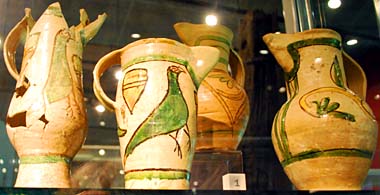
Late 13th century Saintonge ware, Museum of London
Photo © S. Alsford
One example of how merchants "could use material culture as a means of making themselves distinctive." [David Hinton, Gold and Gilt, Pots and Pins: Possessions and People in Medieval Britain, Oxford University Press, 2005, 217] is the glazed pottery of a distinctive style originating in the Saintonge region of Aquitaine, a territory of the English Crown, remains of which products have been found all over Europe. The import into England and purchase of these ceramic jugs and other crockery is closely associated with English merchants involved in the wine trade through Bordeaux; it might be said that these ceramics were a by-product of that trade, the region's potters piggybacking on the huge demand for French wine. Most examples found in England date from the thirteenth and fourteenth centuries. The jugs were probably mainly used for wine, appearing too expensive for households that could only afford to drink ale. The close similarity of some of the polychrome decorative designs, maintained across generations, suggests something approaching mass production; the bird motif (perhaps intended to suggest a heraldic device and appeal to aristocratic purchasers, or those with pretensions towards rising socially) is found on pieces in a number of English museum collections.
There are a variety of ways in which socio-economic status could be outwardly displayed through material possessions. That most commonly cited is costume: the wearing of fur-lined gowns dyed an expensive scarlet colour or other lively colours, sometimes decorated with embroidery, as well as clothing made from imported luxury textiles, in addition to (sometimes flashy) jewellery and waist-purses. That sumptuary legislation tried to restrict the wearing of high-quality clothing and of gold and silver jewellery to the nobility indicates that a growing number of commoners had acquired sufficient wealth and inclination to indulge in such trappings and were vying for a commensurate status, whether real or perceived (Margery Kempe provides an example). This posed a challenge to the established social structure, which relied partly on visual distinctions to maintain the gap between classes. Earlier legislation claimed to be motivated by concern that Englishmen might squander on unnecessaries money that should be spent on equipping themselves to fight for their country, but by that of 1363 it was clear that the underlying concern was a feared threat to the social order when the common people tried to ape their betters.
Other avenues for socio-economic display included: acquiring adjacent property lots in order to erect wider and taller houses, whose timber frames were not plastered over but left visible to impress others, and might even use more timber in the frame than was structurally necessary, just to show surplus wealth; furnishing house interiors more lavishly, such as with painted wall hangings and other purely decorative items, silver plate (or pewter, as a less expensive substitute), furniture for displaying plate, imported ceramics, seat cushions, and elaborate beds; donations towards improving parish church fabric, with visible donor acknowledgements in the form of inscriptions or stained glass depictions.
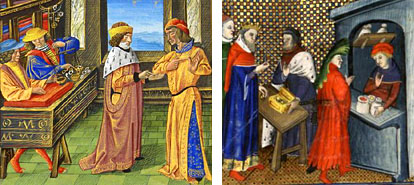
Two depictions of finely-dressed merchants:
(left) in a clothier's shop, from Le Livre de bonnes moeurs de Jacques Legrand,
ca.1490; (right) from an early fifteenth century French manuscript of
De proprietatibus rerum.
Musée Condée and
Bibliothèque nationale de France, département des Manuscrits
Legislation notwithstanding, the merchant class put a good deal of business the way of goldsmiths, who were prominent members of their group and who dealt not just in objects of gold, but also silverware, gilt goods, and jewellery of precious metals and other scarce materials; such valuables represented not only a means of displaying wealth but also of investing it. Finger-rings were popular not only as adornment, or portable wealth, but as business tools – for signet rings, along with seals worn around the neck, were a way of providing personalized authentication to business transactions recorded on tally-sticks or written documents.
Another accessory all but essential to merchants, though again not exclusive to them, were the purses that facilitated carrying around ready cash and perhaps one's personal seal, bearing in mind that medieval clothing lacked pockets. Worn on a belt, or girdle, at the waist, early forms seem to have been simple drawstring bags or pouches of leather or cloth, which could be vulnerable to cut-purses, and made wearers tempting targets for bandits – in 1382 Colchester's court heard a complaint by a villager that two men had waylaid him within the town limits, left him half-dead, and stolen his purse, in which he claimed to have had coin totalling seven shillings.
Over the course of the fifteenth century it became fashionable to have something larger and more elaborate: metal-workers produced frames from which to hang purses of leather, linen or silk – for wealthier townspeople could afford imported silks for various uses. Some frames took the form of horizontal bars with swivelling loops to suspend them from the girdle, while others were pairs of large loops, possibly sewn into the purse proper, again attached to a swivelling suspension mechanism. Some purses appear to have had more than one compartment. Frames may have made the bags less susceptible to cut-purses (some frames being inscribed with prayers, perhaps to ward off thievery); certainly it made them more conspicuous visually. The frame-based purses divided manufacture between two occupational groups, thus creating new employment.
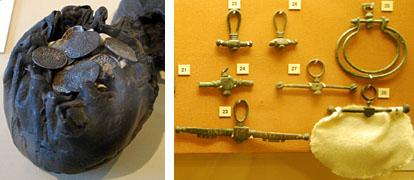
Photos © S. Alsford
Purses of different kinds
(left) a leather drawstring purse, holding coins, found at Pevensey and now on display
in the Barbican House Museum, Lewes; (right) copper alloy purse frames and bars displayed
in the temporary exhibition "The Medieval Mind: Art Treasures from East Anglia”.
Purses were no innovation in the opening centuries of the commercialization of society; similar bags have been found among Anglo=Saxon grave-goods as far back as the sixth century, not necessarily for money nor demonstrably owned by merchants. But by the other end of the Middle Ages purses had become the item perhaps most commonly associated with merchants in iconography. Chaucer noted that all the burgesses on pilgrimage to Canterbury wore purses and he was aware they had become, in effect, status symbols; they were indicative of wealth, of pious generosity, of involvement in commerce, and of a sense of self-worth or at least pretension to being among the upper crust of urban society, able to support financially the burdens of duty incumbent on that elite.
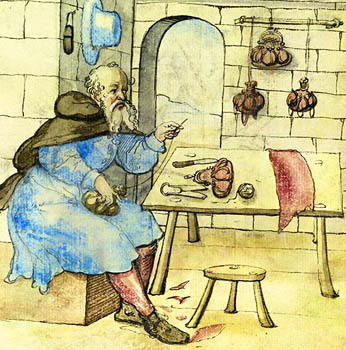
Hans Rossner, a Nuremberg purse-maker
Depicted 1524 in the Hausbuch der Mendelschen Zwölfbrüderstiftung, a record
of inmates of a retirement home. He is shown earlier in life, seated in his workshop,
sewing up a purse, with knife, scissors, yarn, and fabric on the table in front of him,
and discarded pieces of fabric at his feet. From a rack on the rear wall hang finished purses,
and on the side wall a pouch (perhaps his own purse) and his hat.
Valuables needed to be made secure not just on the person of the merchant but in his residence. Chests of various sizes were used not only for clothing storage (largely to protect them from vermin and dust) but also to keep precious possessions such as coin, jewellery, and property deeds secure. The Late Middle Ages saw the production, for individuals and corporations, of strong-box types of chest: reinforced with metal bands, fitted with one or (often) more locks, with fixtures for padlocking, and large metal handles. Thus another spin-off of increased mercantile activity was employment for locksmiths and other craftsmen who collaborated in making such chests; locks and keys are relatively common archaeological finds but wooden chests survive only when passed down the generations. In disturbed and uncertain times, however, even strong-boxes were not felt enough protection by some, who resorted to burying hoards of valuables.
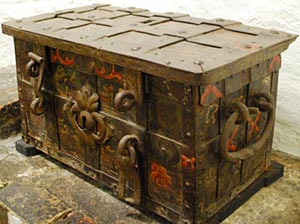
Photo © S. Alsford
Sixteenth century strong-box, Strangers' Hall, Norwich
This merchant's house retains its early fourteenth century cellar, and much of the hall
dates from a mid-fifteenth century rebuild by its mercer resident.
A less secure form of storage was the money-box, a kind of container that has existed as long as there have been coins, and that has changed little in its basics up to the piggy-banks of the present day: simple pottery containers with a slit for inserting coins, which could only be retrieved by smashing the box. Some medieval versions were made in the form of animals.
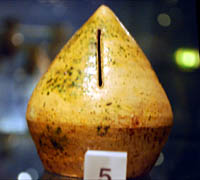
Early fourteenth century money-box, Museum of London
Photo © S. Alsford
Balances were another item of equipment that merchants required, for weighing both merchandize and the coins used to pay for it. Since clipping or shaving of the edges of coins was a common fraud, sellers might want to check those they received were the standard weight; how common a practice this was is hard to say, and in a hypothetical cloth transaction the seller uses her own judgement to accept the buyer's word that the coins he offers are legal tender. The association of balances with merchants was almost as iconic as that of merchants and purses. Along with balances, merchants needed to own a set of weights and/or measures, appropriate to the type of goods in which they dealt. At ports or marketplaces equipped with an official weigh-beam, there would have also been a set of official weights.
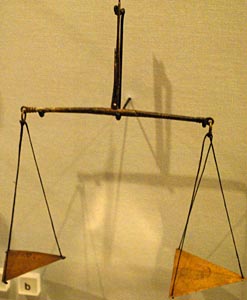
(above) Portable scales of the type carried about by travelling merchants. For exhibition
purposes the Museum of London has combined a late medieval balance arm (foldable for
more portability) with triangular balance pans of the sixteenth century. This was
the kind of balance used to check coins.
(below) Thirteenth-century weight, Barbican House Museum, Lewes.
Photos © S. Alsford
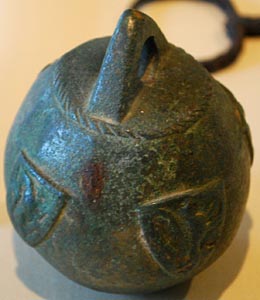
Found in Lewes by archaeologists, the above weight, of bronze exterior and lead interior, was for use with a steelyard: a ceiling-suspended straight-beam balance on which can be hung a weight that slides along a calibrated arm until the load hanging from the other (shorter) end of the arm is balanced. This kind of weighing apparatus was used in the Ancient World, but probably acquired its medieval name from the Steelyard, the London base of the Hanseatic merchants, who voyaged with this kind of portable balance. The arms of the Hanseatic League appear on it, so it may have belonged to a Hanse merchant. But also on it are the arms of Richard, Earl of Cornwall (brother of Henry III), who was elected king of Germany in 1257, sponsored the Hanse community in London obtaining a royal charter in 1260, and was captured at the Battle of Lewes four years later.
During the first half of the fourteenth century a number of petitions to the king expressed concern about fraud during the weighing process; while these were particularly aimed at the auncel, weigh-beams using scales on either side could also be manipulated by crafty use of hand or foot. In banning fraud during weighing, a statute prescribed for offenders a year's imprisonment, confiscation of the goods falsely weighed, and compensation for injured customers in the amount of four times the value of those goods. Even this severe punishment failed to have sufficient effect, and in 1428 the Church announced that any user of auncels or of false weights would be excommunicated.
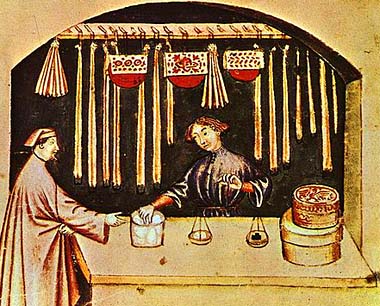
A shopkeeper (perhaps a spicer or chandler) uses hand-held scales
to weigh a small quantity of luxury goods (possibly sugar) for his customer.
An illustration from the Tacuinum Sanitatis
It is not hard to see how increasing demand for the kinds of items mentioned above would have stimulated the development of industry. Similarly, the ship-building sector of the economy would have benefited from the growth of long-distance commerce. Not only in building more merchant vessels but in improving designs. Initially there was a desire for cargo ships that could carry larger loads; this was in a period when English merchants were competing with foreign counterparts for a greater share of international trade and there was a certain ebullience within the community of importers and exporters, for whom ships perhaps represented an upper-end symbol of wealth and success in business. But large ships were uneconomic to operate except for truly long-distance voyages. Towards the close of the Middle Ages, after a period of economic decline, when much overseas commerce had been focused (as various wars and souring international relations closed down some trade routes) on short-run routes, and with the unremitting silting up of not a few English estuaries, interest reverted to smaller ships that could better deal with shallower coastal and inland waters, both in England and abroad.
Not that all merchants owned ships, let alone had ships built for them; far from it; the number of English-produced ships involved in commerce in the Late Middle Ages was much smaller than in modern times and relatively low compared to other countries of medieval Europe. Many English merchants preferred freight arrangements in ships owned by others – often foreigners, who tended to have larger vessels – as spreading their merchandize across multiple vessels was less risky than exposing one's own ship plus cargo to piracy, maritime warfare, or wreck. Spreading risk and costs likewise encouraged co-ownership of vessels. Even when merchants invested in their own ships, they might acquire ships built abroad, some of which had been seized as enemy vessels.
Nonetheless, for the national muster of ships in 1346 for an assault on Calais, some 700 vessels were assembled; 217 of these belonged to residents of East Coast ports [according to G.V. Scammell, "English Merchant Shipping at the End of the Middle Ages: Some East Coast Evidence," Economic History Review, vol.13, 1961, 339], which collectively represented about half of the two dozen wealthiest towns in England. This is not to mention barges used for river travel. Such ownership provided employment for shipwrights, mariners of all kinds, and ancillary industries (such as rope-makers, sail-makers). Wheelwrights, coopers, goods handlers, horse-traders, among others, would likewise have had economic benefit as a spin-off from the proliferation of mercantile activities.